A simple guide to improving services - NHS Improvement System
A simple guide to improving services - NHS Improvement System
A simple guide to improving services - NHS Improvement System
- No tags were found...
You also want an ePaper? Increase the reach of your titles
YUMPU automatically turns print PDFs into web optimized ePapers that Google loves.
FIRST STEPS TOWARDS QUALITY IMPROVEMENT: A SIMPLE GUIDE TO IMPROVING SERVICESWhy do projects fail?A project plan should specify:• Aims and objectives• Background <strong>to</strong> the project• Scope of project• Expected deliverables• Timescale• Analysis of risk• Resources• Budget• Method/process• Accountability• Identification of the project sponsor• Data and measures• Dependencies (i.e. links between oneaction and another)• How the work is going <strong>to</strong> be sustainedand spread <strong>to</strong> other areas.• Project aims and objectives notclearly defined or articulated• Little or no <strong>to</strong>p level supportand leadership for the project• Lack of effective engagementwith key players and patients• Poorly planned projects• Inadequately moni<strong>to</strong>red,controlled and managed• Failure <strong>to</strong> take account of localand national priorities e.g. QIPP• Poor communication• Failure <strong>to</strong> divide the project in<strong>to</strong>small manageable tasks• Unable <strong>to</strong> collect and analysedata.Project plans come in many different styles, buteach should set out all the actions that have <strong>to</strong>occur <strong>to</strong> achieve the improvement, as well asclearly stating when these will happen andwho is responsible for doing them.Is my work a project?A project is a temporary piece of workwith a defined start and finish, and willnot continue indefinitely. Project workis also designed <strong>to</strong> deliver a definedoutcome or benefit from doing thework.Does someone need <strong>to</strong> projectmanage for a project <strong>to</strong> besuccessful?Yes, within the project team, someoneneeds <strong>to</strong> be responsible for the role.Without someone <strong>to</strong> undertake thisrole, it is unlikely that even the smallestproject team will deliver what it setsout <strong>to</strong> achieve within the agreedparameters.Isn’t project management justunnecessary bureaucracy andadministration?Good project management is not justbureaucracy. It is about ensuring thereis consistent co-ordination, drive andevaluation of the project so that itremains focused and effective. Nothaving someone <strong>to</strong> manage theproject usually means that no onetakes overall responsibility for ensuringthat all the components are beingdelivered – and the project may thenfalter or fail.What is the difference between aresearch and improvement project?An improvement project is abouttesting ways <strong>to</strong> implement evidencebased care and find out the best wayfor a service <strong>to</strong> be organised anddelivered. It is about testing innovationor new ways of working and not abouttesting whether treatments orinterventions actually work.What is the role of a projectmanager?The role of a project manager is <strong>to</strong>have oversight of the entire projectand take responsibility for controllingand moni<strong>to</strong>ring each aspect, alongwith reporting the successes, learningand failures of the project. Not everyproject needs <strong>to</strong> a dedicated projectmanager, but every project requiressomeone <strong>to</strong> undertake the roles andresponsibilities of a project manager(see chapter 5).12/13
FIRST STEPS TOWARDS QUALITY IMPROVEMENT: A SIMPLE GUIDE TO IMPROVING SERVICESCHAPTER 4Levers and drivers - framing thework for a wider audienceChanging established systems of any kind isdifficult. It is particularly challenging withinhealthcare because of the complexrelationships between a wide range oforganisations, professionals, patients andcarers.Certain fac<strong>to</strong>rs may help <strong>to</strong> foster anenvironment that is conducive <strong>to</strong> changeand improvement. An organisation wherethere is strong leadership and everyone isfocused on <strong>improving</strong> patient care is morelikely <strong>to</strong> develop motivated staff with adesire for continuous quality improvement.However, barriers <strong>to</strong> changing establishedpractice may prevent or impede progress inall organisations, whatever the culture.Sometimes a great idea can be presentedwith various barriers and challenges <strong>to</strong>change. Often taking time <strong>to</strong> identify thebarriers in order <strong>to</strong> overcome these isessential <strong>to</strong> securing engagement andsustainability of the work. It is alsoimportant <strong>to</strong> look at the context of workyou may be undertaking in terms ofunderstanding both the local and nationaldrivers for change and levers for improvement.What levers and drivers could berelevant <strong>to</strong> my work?You might need <strong>to</strong> do some researchabout local and national priorities. Quiteoften these are obvious and you canbegin <strong>to</strong> ‘frame’ your work <strong>to</strong> align <strong>to</strong>these. For example, you might beundertaking a project in primary care <strong>to</strong>reduce the number of emergencyadmissions <strong>to</strong> hospital where the localpriority is <strong>to</strong> reduce bed days. Therewould be a clear link <strong>to</strong> the localinitiative and the work you would thenundertake.What is QIPP?QIPP stands for Quality, Innovation,Productivity and Prevention andoriginates from the White Paper‘Equity and excellence: Liberating the<strong>NHS</strong>’ which sets out the government’svision for the future of the <strong>NHS</strong>. TheQIPP agenda is all about ensuring thateach pound spent is used <strong>to</strong> bringmaximum benefit and quality of care<strong>to</strong> patients. The QIPP initiative hasbeen increasingly important inhealthcare and looks set <strong>to</strong> continueas the <strong>NHS</strong> needs <strong>to</strong> make savingsbecause of increasing demand from anageing population and the increasingneed for long term conditionmanagement. The <strong>NHS</strong> needs <strong>to</strong>achieve value for money and the bestpossible quality of care so that patientsget the greatest benefit.More information can be found onwww.improvement.nhs.uk/qippHow do I link my work <strong>to</strong> local priorities?Talk <strong>to</strong> the local stakeholders about the work you propose and understand how it fits in. Anumber of these stakeholders may already be part of your project steering group, so taketime <strong>to</strong> discuss and explore this further with them. Your local clinical network may also beable <strong>to</strong> help you link <strong>to</strong> local priorities.Drivers are those forces for change that areoutside the projects scope of control.Drivers derive from a variety of sources,including policy, that will change the way inwhich the service may operate. Levers arethose forces for change and improvementthat are within the projects scope of control.In parallel, linking with what is first seen asprimarily a small improvement project withlocal and national drivers for change canenable a project <strong>to</strong> be further supported,successful and sustainable. Quite oftenteams undertaking improvement projectsfocus purely on delivering isolated outcomesfor their work areas. Levers such asreducing admissions or length of stay maybe a local priority for a number oforganisations in your area. It will help raisethe profile of your improvement work if thework is aligned <strong>to</strong> such initiatives, howeversmall.Look for similar current work alreadyunderway within your organisation.Consider framing your work <strong>to</strong> the NationalQIPP agenda in terms of qualityimprovement, innovation, productivity gainsand prevention work. You may be surprisedby how much difference your improvementwork contributes <strong>to</strong>wards reducing costs,enhancing productivity, enhancing qualityand increasing patient safety.There are a number of local and nationalinitiatives looking <strong>to</strong> improve local <strong>services</strong>including calls for case study examples ofgood practice. It is worth spending sometime investigating what drivers are aligned<strong>to</strong> your work, similar work within yourorganisation and opportunities <strong>to</strong> gainadditional support where it may beappropriate.How can I get wider engagement <strong>to</strong>support my work?Raising the profile of the work,particularly if the work is aligned <strong>to</strong> localpriorities will increase the chances ofwider engagement and support for thework. Talk <strong>to</strong> the service stakeholdersand try <strong>to</strong> secure project sponsorshipfrom the chief executive or board leveldirec<strong>to</strong>r within your organisation. Alsodiscuss the work with othermanagement and clinical colleagues butremember that these individuals mayspan wider than your immediate projectgroup and include, primary care, socialcare, acute care, commissioners and theambulance service where relevant. Yourlocal clinical network may also be able <strong>to</strong>assist with wider engagement and supportfor your work.What is a clinical network?A clinical network is a local <strong>NHS</strong>organisation made up of clinicians,managers and commissioners who work<strong>to</strong>gether <strong>to</strong> improve care. They provide aforum <strong>to</strong> share multi professional advice,influence and learning, <strong>to</strong> maximiseknowledge and deliver better outcomesfor patients. They do this by bringing<strong>to</strong>gether primary care, secondary care,commissioners, patients, social care andother stakeholders with a commoninterest, <strong>to</strong> enable the local <strong>NHS</strong> <strong>to</strong> workin a collaborative and co-ordinated wayfor its population, <strong>to</strong> best meet localneeds and priorities.How can a clinical network help?Networks focus on solving problems forpatients wherever they are in the system,stepping outside organisationalboundaries and seeking instead a wholesystem approach <strong>to</strong> serviceimprovement. Networks will also shareinformation, best practice, <strong>guide</strong>lines,and clinical learning <strong>to</strong> achieve greaterimpact than would otherwise bepossible. They can also influencecommissioning decisions about priorities,availability and use of resources, <strong>to</strong>deliver optimum care <strong>to</strong> local people.If your project demonstrates significantscope <strong>to</strong> improve care, efficiency andoutcomes a network can help youspread and sustain your work.14/15
FIRST STEPS TOWARDS QUALITY IMPROVEMENT: A SIMPLE GUIDE TO IMPROVING SERVICESCHAPTER 5Getting the right peopleinvolvedSome of the biggest risks <strong>to</strong> any project cancome from within the team. It is importantthat the team has people with the right skillsand abilities <strong>to</strong> do the job and will be able <strong>to</strong>give continued support <strong>to</strong> the improvementinitiative.Having the right people involved from thebeginning with the right expertise will giveyour project the best chance of sustainablesuccess. If the right people are not involvedfrom the start, it will be much harder <strong>to</strong>engage and involve these people at a laterdate.A project sponsor and involvement fromthe <strong>to</strong>p of your organisation (Chief Executiveor Executive Team) is necessary <strong>to</strong> championyour project and provide strategic direction<strong>to</strong> the project. This type of involvement alsoprovides support <strong>to</strong> discuss issues, celebrateachievement and provide access <strong>to</strong> humanresources, finance, analysts, communications,estates and IT teams when required.Why do I need an executive sponsor?Executive sponsors should be chosenfrom the <strong>to</strong>p of your organisation, ideallythe chief executive or someone from theexecutive team. This person willchampion your project, provide strategicsupport <strong>to</strong> the project, help <strong>to</strong> discussand resolve issues, celebrateachievement and provide access <strong>to</strong> HR,Finance and IT teams when required.Why is clinical and managerialleadership important for my work?Clinicians and managers providedifferent perspectives, experience andsupport <strong>to</strong> your project. They will helpensure that your project is appropriatelytargeted and relevant. Also they canensure that the changes you are testingare practically supported and promotedacross different staff groups.How do I keep colleaguesengaged?Once you have built the relationshipand engagement has been achieved,continue <strong>to</strong> work at it by:• Staying in regular contact• Keeping people involved andupdated• Having meetings with apurpose, actions and outcomes• Delivering what you haveagreed <strong>to</strong> do.Every project should have someone with anoverview of the project who is responsiblefor the role of project manager. Youmight be fortunate <strong>to</strong> have a dedicatedproject manager <strong>to</strong> support your project,however a project member may be required<strong>to</strong> take on the responsibilities of this rolewhere this is not possible. It is advisable forjust one person <strong>to</strong> be accountable and haveownership <strong>to</strong> lead the project, ensuringdecisions are made, actions taken, andmeasurable, timely progress is made.Involve all stakeholders and grades of staff(clinical staff, GPs, porters, commissioners,reception staff, managers, pharmacists,clinical support staff, data analyst, medicalsecretaries etc) as they will have differentexperiences, knowledge, skills, opinions,ideas and concerns.The involvement of patients, carers andcharities is vital as they will be able <strong>to</strong> give adifferent perspective on your service andproposed improvement plans.Within the project team it is necessary <strong>to</strong>have a variety of individuals, some whoserole will be <strong>to</strong> make decisions and others <strong>to</strong>carry out actions.When establishing a project team, considerindividuals or groups who are interested andenthusiastic about the work, and those whoare in a position of power and influence. Itis also worth involving people or groupswho do not have direct interest in yourproject but have a key position of power orauthority <strong>to</strong> make decisions.16/17
FIRST STEPS TOWARDS QUALITY IMPROVEMENT: A SIMPLE GUIDE TO IMPROVING SERVICESCHAPTER 6Involving patients and carersin service redesignPatients and their carers are the reasonthe health service exists and thereforethey should be at the heart of our<strong>services</strong>.Why should I involve patientswhen I know what I need <strong>to</strong> do?Patients’ experience of what we say,do or mean can be very different <strong>to</strong>that which we intend. By activelyinvolving patients, we can find outhow what we do actually affectsthem, what really happens day <strong>to</strong> dayand what we could do <strong>to</strong> improvepatients’ experience, reduce wastefulprocesses and improve quality.Service improvement and redesigngenerates opportunities <strong>to</strong> involve usersand their carers who can provide a differentperspective <strong>to</strong> enable a better understandingof whether our improvements make anydifference.A patient’s experience of our service can bevery different <strong>to</strong> what we intend or assumeit <strong>to</strong> be and they can tell us what works,what doesn’t and what could be donebetter. We might ‘know’ we are doing agood job, but it needs <strong>to</strong> meet the patient’srequirements.Only when we understand a patient’s needs– by asking them, not second guessing – canwe work in a way that meets those needsand ensures they get maximum benefit fromour service.graham@ogilviedesign.co.ukWhy should patients and carers beinvolved in the improvement of<strong>services</strong>?• Raised awareness of how the service reallyruns from the patient point of view, notjust how the service providers think it runs• Different perspective on improvementsand priorities• Opportunity <strong>to</strong> discover what really makesa difference <strong>to</strong> a patient’s experience• Understanding what makes it difficult oreasier for the patient <strong>to</strong> manage theircondition effectively• Suggestions <strong>to</strong> make things quicker,cheaper, easier or better <strong>to</strong> improve<strong>services</strong> and experience for patients andcarers• Learning more about the patient’s actualexperience and so providing a betterunderstanding of their needs and priorities• Improved service user relationships withhealthcare professionals• Opportunity <strong>to</strong> raise issues of importance<strong>to</strong> patients, carers and the public• Improved and increased staff morale fromproviding care <strong>to</strong> patients that they want,in a way they want18/19Planning before involvingPlanning is imperative <strong>to</strong> ensure that thehealthcare provider fully understands whatthey want from the interaction and howthey are going <strong>to</strong> meaningfully involvepatients and carers.The following planning steps should beundertaken before interaction with patientsand carers:• Be clear about what you want frominteraction and what you are trying <strong>to</strong>achieve• Address any staff concerns about patientinvolvement/engagement• Consider what previous patientinvolvement has taken place and if thiswas successful. If not, why not?• Decide on the type of patient – someonewho is well informed about theircondition, newly diagnosed patient,recently discharged etc.• Decide where are you going <strong>to</strong> enlist thistype of patient?• Decide on the level and method ofinvolvement you are going <strong>to</strong> use – i.e.direct, indirect questioning• Ensure you have enough resources inplace, e.g. time, finances, training• Consider any practical arrangements thatneed <strong>to</strong> be made• Test the method you propose <strong>to</strong> use, thenamend where necessary• Establish plans for evaluating yourapproach.Where can I find patients and carerswho may support my work?There are many ways in which you caninteract and contact patients and carers whowould like <strong>to</strong> be involved in serviceimprovement work. You can approachpeople in your clinic, through hospitaldepartments, nurse specialists and patientgroups.Some organisations which can support theplacement of volunteer patients and carersin service improvement work in the <strong>NHS</strong>include:• Local Involvement Networks (LINks) / LocalHealthWatch (www.nhs.uk)I want <strong>to</strong> know more, where can Ifind detailed information?<strong>NHS</strong> <strong>Improvement</strong> has years ofexperience in involving patients andtheir carers. Information can befound on our website:(www.improvement.nhs.uk/ppe)along with information aboutDiscovery Interviews which is aninnovative technique designed <strong>to</strong>improve care by gaining insight in<strong>to</strong>patient and carer needs andexperiences:www.improvement.nhs.uk/discoveryinterviews.
FIRST STEPS TOWARDS QUALITY IMPROVEMENT: A SIMPLE GUIDE TO IMPROVING SERVICES• Charitable organisations such as theStroke Association, MacMillan CancerSupport and Asthma UK (find localinformation on the charity websites)• Local support groups• Patient Advice and Liaison Service (PALS).You may also like <strong>to</strong> consider advertisingyour improvement work and asking forvolunteers through:• Posters in GP surgeries, outreach clinics,hospitals or other <strong>NHS</strong> settings• Posters in libraries and pharmacies• Social networking sites such as Facebookand My Space.What are the considerations forinvolving patients and carers?Sensitivity – the patients actually sufferfrom and live with their conditions / illnessesand sometimes service redesign work maytake a depersonalised approach. This shouldbe considered if patient representativesattend meetings or improvement events.graham@ogilviedesign.co.ukCost – undertaking some forms of patientinvolvement may incur a cost for the patient.It is reasonable <strong>to</strong> expect that patients andcarers should receive reimbursement for thecosts they incur – travel, parking etc.Representative sample – there is often achallenge in finding patients who arerepresentative of the service you are working<strong>to</strong> improve. For example, if meetings arearranged during working hours it is highlyunlikely that people of working age wouldbe able <strong>to</strong> attend because of other lifecommitments such as work and children. Ifyou wish your patients <strong>to</strong> be trulyrepresentative you may have <strong>to</strong> consider anumber of methods.A range of opinions – patient engagementmay elicit a different or even opposingopinion <strong>to</strong> the work you are undertaking. Itis important <strong>to</strong> know from the outset how<strong>to</strong> manage expectation realistically but also<strong>to</strong> genuinely incorporate views and makechange.Examples of techniques <strong>to</strong> involve patients and carersDirect methodsInterviewsFocus groupsWorkshopsFace <strong>to</strong> face meetings with individualsPatient reps on project groupsPatients attending service improvement eventsIndirect methodsQuestionnairesSurveysSuggestion boxesAnalysis of complaintsPublic meetings / open daysSocial networkingTop tips for involving patients• Listen• Find ways <strong>to</strong> involve the seldom heard groups, those who find it difficult<strong>to</strong> access health <strong>services</strong> or people who may not routinely get involved sothat you get a real understanding of different experiences• Take time <strong>to</strong> understand the issues, don’t assume you know the answer orthe solution• Use appropriate language, not jargon• Be clear about why you are undertaking involvement work andhow you will deal with what it reveals• Be clear about any areas that can not be changed or are not for discussion(e.g. national guidance), this ensures that the valuable time is spentdiscussing what can be changed and that patients expectations are notunduly heightened• Always provide feedback <strong>to</strong> the patient and what has happened as aresult?20/21
FIRST STEPS TOWARDS QUALITY IMPROVEMENT: A SIMPLE GUIDE TO IMPROVING SERVICESCHAPTER 7Communicating the right things<strong>to</strong> the right peopleWhy should I invest time <strong>to</strong>communicate what I know?Don’t assume that other people(including your staff and colleagues)know what you know. Everyoneconnected <strong>to</strong> the service needs <strong>to</strong>understand what you are doing andwhy, and the impact it is having.Communication not only keepseveryone up-<strong>to</strong>-date on the projectprogress, but raises the profile of yourproject and facilitates engagement andownership of the vision and servicechanges. To ensure the success of aproject, information including the aims,objectives, expectations, deliverables,timescales, progress, risks, challenges andachievements need <strong>to</strong> be communicated ona regular basis.Through two way communication, youwill probably find that the staff who workin the area are fully aware of changes thatcan improve the service. Throughinvolvement, empowerment and listening,staff generated ideas and solutions aregenerally most effective and sustainable.Following meetings with staff, make sureyou take action and communicate theprogress you have made. Smallimprovements can ignite momentum for theproject and start <strong>to</strong> get people interested.How often are you going <strong>to</strong>communicate?• Daily, weekly, monthly.Who is going <strong>to</strong> be responsible for thecommunication?• Project manager• Executive sponsor• Named people• Everyone.“ You can have brilliantideas but if you can't getthem across, your ideaswon't get you anywhere.”Lee LacoccaKeeping the improvement at theforefront of people’s minds whenthings are going well will ensure theyremain engaged and committedwhich will make it easier for you <strong>to</strong>gain support when you need it.Don’t expect people <strong>to</strong> dropeverything <strong>to</strong> help you if they haveheard nothing from you for the lastsix months! By communicating whatyou are doing <strong>to</strong> others in yourdepartment or organisation, youmight also find out informationwhich you were not already aware ofthat may have a positive or negativeimpact on your work.The first step <strong>to</strong> effectivecommunication is <strong>to</strong> understand whoyou need <strong>to</strong> communicate with• Who do you need <strong>to</strong> keep informed andobtain information from? Staff/patients/carers/executive board?• Who needs <strong>to</strong> know what is happening /changing?• Who do you require support from?• Who will be directly and indirectlyaffected?Communication PlanTeam: Completed by: Date:Who are you going<strong>to</strong> communicatewith?e.g. Project teams,exec sponsor, <strong>NHS</strong><strong>Improvement</strong>, steeringgroup, SHA lead,stakeholders, patientsetc.What are you going<strong>to</strong> communicate <strong>to</strong>them?e.g. <strong>Improvement</strong>s,risks and issues,measures, data,project scope, newsetc.How are yougoing <strong>to</strong>communicate?e.g. Weeklymeetings,presentations,events, email,letters, handoutsetc.When are yougoing <strong>to</strong>communicate it?e.g. Daily, weekly,fortnightly,monthly, annuallyWho is responsiblefor communicatingthe message?Name and roleWhat do you need <strong>to</strong> tell or ask? Whatdoes your audience need <strong>to</strong> know?• What the current service looks like• The vision, aim, deliverables• The problems, issues, risks• Changes <strong>to</strong> the project• The benefits.How are you going <strong>to</strong> communicate <strong>to</strong>all the relevant people?• Regular meetings• Internal and external newsletters• Memo’s• Local press• Websites• Emails• Letters• Reports• Presentations• Support from the communicationsdepartment?22/23Communication planA communication plan is an easy way <strong>to</strong>actively address the interests and concernsof the key stakeholders and ensures this isdone in a timely manner.In a changing environment withorganisational structures being transformedand staff moving roles, a documentedcommunication plan will support theprogression of an improvement project.Example of how a team at HinchingbrookeHospital communicated their work in thelocal pressWhat is the best way <strong>to</strong>communicate the progress andoutcomes of my work?Remember that you will need <strong>to</strong>adopt different approaches and stylesfor different audiences andstakeholders. Try not <strong>to</strong> develop awhole industry of reporting aroundyour project but use existing channelswherever possible. Involve your localcommunications team as they will beable <strong>to</strong> suggest some possibilities.Regular reports <strong>to</strong> your executivesponsor, board or managementcommittee are useful at the higherlevel, but make sure you also uselocal newsletters, forums andmeetings <strong>to</strong> provide ongoingupdates.
FIRST STEPS TOWARDS QUALITY IMPROVEMENT: A SIMPLE GUIDE TO IMPROVING SERVICESCHAPTER 8<strong>Improvement</strong> <strong>to</strong>ol: ProcessmappingA process is made up of series of actions orsteps taken <strong>to</strong> achieve a specific result.Process mapping is a technique used <strong>to</strong>identify all the interconnected pathway stepsand decisions in a process and coverts thisinformation in<strong>to</strong> a highly visualdiagrammatic form.Process maps can cover a short and <strong>simple</strong>sequence of actions by one person (such aspoint of care testing or phelbo<strong>to</strong>my) or itcould be a complex set of activities involvingmany different people over time, (such asthe End of Life patient pathway).What are the benefits of mappingthe process?• An overview of the complete process frombeginning <strong>to</strong> end, helping staff <strong>to</strong>understand, often for the first time, howcomplicated the system can be forpatients• Allows staff <strong>to</strong> see the pathway from thepatient’s perspective• A starting point for your improvementprojectPeople’s views about the process tend <strong>to</strong>change and develop following a processmapping exercise as individuals have an idea(a ‘mental map’) of the process, but as theprocess map is developed, it becomes clearthat their personal view is different fromthat of others in the same process. The mapof the current process may differ from themental maps that individuals in that processhave always believed. Agreeing the currentGP referral <strong>to</strong>community nursespecialist teamSpirometry x3(which need <strong>to</strong> bewithin 5%) by band2 or 6 staff400mg salbutamol(via volumatic)If referral doesn’t meet set standards,more information is requested from GPor if does not meet the triage standards,letter back <strong>to</strong> GPReferral triaged bycommunity specialistteamMeasure oxygensats20 minute wait(for medication<strong>to</strong> work)Patient contactedby community team<strong>to</strong> arrange anappointment whichis close <strong>to</strong> patientshomeCheckmedicationRepeat spirometryx3COPD and Asthma DiagnosisCommunicationletter sent <strong>to</strong>patient with PILCheckdemographicsExplain results<strong>to</strong> patientWrite <strong>to</strong> GP andpatient formanagementprocess is an important step in movingforward <strong>to</strong> redesign and developing a newprocess that will work better for patientsand staff.What does a process map look like?The map below is of a diagnostic pathwayfor chronic obstructive pulmonary disease(COPD) and asthma.Community teambook secondary care<strong>to</strong> staff <strong>to</strong> run clinicsCheck heightand weightResults takenback <strong>to</strong> secondarycareDecisions fortreatment andmanagementClinic referralssent <strong>to</strong> secondarycarePatient calledin<strong>to</strong> clinicIf spirometryconducted by band2 staff resultsinterpreted byband 6Review andinterpretationSecondary caremanager (band 6)arranges staff <strong>to</strong>cover clinicsSecondary careattended for clinicIndication andcommentsdocumented andprintedResults sent <strong>to</strong>primary care nursespecialist team• The opportunity <strong>to</strong> bring <strong>to</strong>gether peoplefrom primary, secondary, tertiary andsocial care from all roles and professions• Identifies problems, delays, areas for errorand confusion, blockages and bottlenecks• A point <strong>to</strong> create a culture of ownership,responsibility and accountability for<strong>improving</strong> the process• An aid <strong>to</strong> help plan where <strong>to</strong> test ideas forimprovements that are likely <strong>to</strong> have themost impact on <strong>services</strong>• Draws out ideas <strong>to</strong> help redesign thepathway – which particularly frommembers of staff who don’t normally havethe opportunity <strong>to</strong> contribute <strong>to</strong> serviceplanning, but who really know howthings work• An interactive event that gets peopleinvolved, motivated and talking <strong>to</strong> eachother• An end product – the process map –documents who does what, when, andhow long it takes, is highly visual and easy<strong>to</strong> understand.Once the above map was completed, the team could see that the process was overcomplicated,and included many unnecessary steps, bottlenecks, wasteful activities andavoidable delays. The process was redesigned following the mapping exercise the newprocess below was created. As well as being <strong>simple</strong>r, the new process is much quicker forthe patient, takes less administrative and clinical time and costs less.GP referral <strong>to</strong>community nursespecialist teamIf referral doesn’tmeet set standards,more informationis requested from GPor if does not meetthe triage standards,letter back <strong>to</strong> GPReferral triaged bycommunity specialistteamHow <strong>to</strong> organise an event andgenerate a process mapPatient contactedby community team<strong>to</strong> arrange anappointment whichis convenient inproximity and timePreparation• Define the objectives, scope (start and endpoints and level of detail) and the focus ofthe process mapping workshop• Start is with a process that involves highnumbers of patients• Organise a half day event <strong>to</strong> draw themap and a half day <strong>to</strong> analyse and lookfor improvement opportunities. You canrun these <strong>to</strong>gether as a full day event or astwo half days but not more than twoweeks apartCommunity Spirometry ManagementCommunicationletter sent <strong>to</strong>patient with apatient informationand instructionleafletBand 2 staffSpirometry withreversablility, SpO2by secondary careteamBand 6 staffor aboveInterpretation insecondary care byband 6 or aboveInterpretation andresults explained<strong>to</strong> patientIndication andcommentsdocumented andsent <strong>to</strong> primarycare specialistnurse teamProactive approach<strong>to</strong> treatment andmanagement whichmay include tier 3clinic attendance,MDT discussions• Meet with managerial, clinical and serviceleaders beforehand so that they feelinvolved in the process. Use thesemeetings <strong>to</strong> agree the scope that you willwork on and the three or four basic stepsthat you will explore in detail at theworkshop• If you have the opportunity, anindependent facilita<strong>to</strong>r, not connectedwith the pathway, can be really useful.Choose someone with service redesignskills and experience.24/25
FIRST STEPS TOWARDS QUALITY IMPROVEMENT: A SIMPLE GUIDE TO IMPROVING SERVICESWho and how <strong>to</strong> invite• You need <strong>to</strong> invite people who support,deliver and manage the entire scope ofthe process you wish <strong>to</strong> map. This mightinclude people from primary, secondary,tertiary and social care from all roles,grades and professions• Consider how staff will be released fromtheir job for the mapping event• You may wish <strong>to</strong> invite patients and carers<strong>to</strong> give their perspective and ideas• The invitation should come from yourproject sponsor• The invite include information on thebackground <strong>to</strong> the event, aim of the event,expectations, scope of the mapping etc• It is advisable <strong>to</strong> request that the invitedparticipants walk through the pathwaywhich is going <strong>to</strong> be mapped before theevent.Venue• Arrange a suitable venue, preferably offsite,as this will provide a neutral settingand people are less likely <strong>to</strong> be interruptedand it will be easier <strong>to</strong> concentrate on thetask in hand. Don’t forget <strong>to</strong> organisesome refreshments – process mapping canbe thirsty work!Equipment• You will need a long roll of paper(wallpaper lining or a roll of brown paper),coloured post-it notes, lots of markerpens, sticky tape and two flip charts,preferably with stands.• Write each step on an individual post-itnote and stick them <strong>to</strong> the backing paper.The benefit of post-it notes is that you canmove them around if you need <strong>to</strong> addsome extra steps• Concentrate on what happens ‘most ofthe time’ rather than what occasionallyhappens• If problems or issues are raised whichcannot be resolved in the room or in adefined timescale, e.g. 10 minutes, writethem on your ‘Car Park’ flipchart ready <strong>to</strong>be addressed at a later date.What level of detail?You may map a process at ‘high level’ <strong>to</strong> obtain a clear outline of the major steps involved:Put kettle onGet cupOr at a more detailed level <strong>to</strong> identify the complex steps in one or more stages of the journey.OpencupboardPut kettle onPut tea bagin cupChoose cupGet cupPut waterin cupSelecttea bagI’ve already process mapped -Do I need <strong>to</strong> do this again?Review your map. Is it valid? Haveyou checked with all those involved,including patients? What changes didyou make after you completed yourmap? Sometimes process mapping isseen as an end in itself – it is not. Youneed <strong>to</strong> use your map as a <strong>to</strong>ol <strong>to</strong>identify where and how you can start<strong>to</strong> make changes and how you canevaluate their impact.Put tea bagin cupRemovetea bagWarm cupPut waterin cupAdd milkAdd tea bag<strong>to</strong> cupDrink teaSet up• Use a roll of brown paper or wallpaper,fixed firmly <strong>to</strong> the wall• Write ‘Ideas’ on one flip chart. This flipchart can be used <strong>to</strong> capture all ideas thatarise throughout the mapping exercise• Write ‘Car Park’ on the other flip chart.This is used <strong>to</strong> capture all issues that cannot be resolved in a defined amount oftime or are not directly relevant <strong>to</strong> themap but need <strong>to</strong> be addressed.Start of event• Ask one of the lead clinicians or yourproject sponsor <strong>to</strong> open the event,emphasising their own commitment <strong>to</strong> theevent and redesigning the process• If everyone doesn’t already know eachother, have a round of introductions• Set some ground rules – these may include;listening <strong>to</strong> each other, no opinion is wrong,no blame will be cast, it’s the process notindividuals that is at fault.Mapping the process• Review the agreed start and end of theprocess• Agree the level of detail. It is best <strong>to</strong> startat a very high level and then drill down <strong>to</strong>the detail where necessary• Start with some main headings mappedout on the paper – these might include:‘presenting symp<strong>to</strong>ms’, ‘referral’,‘diagnosis’ etc. – the ‘high level’ steps inthe process. This can help <strong>to</strong> remindpeople that the purpose of the event is <strong>to</strong>map the whole of the journey, not just theelements they are familiar withAnalysing your map• From your process map you will be able <strong>to</strong>identify where the significant problemsoccur. This might be the most prevalentwaits, delays, duplication, bottlenecks,constraints or inefficiencies <strong>to</strong>gether withthe presence of any ‘non value adding’activities such as unnecessary hand offs(where the patient is passed from oneperson <strong>to</strong> another), transfer <strong>to</strong> queue orexcessive administrative checks:• There are four main techniques <strong>to</strong>redesigning your process map:• Eliminate• Combine• Simplify• Sequence.Where possible, try <strong>to</strong> eliminate any processsteps. If it isn’t possible <strong>to</strong> eliminate anysteps, look <strong>to</strong> combine steps. Aftercombining, consider where the system canbe simplified. Once steps in the process havebeen have been eliminated, combined andsimplified, review the sequence of events <strong>to</strong>promote efficiency:• Measure or time the process steps in order<strong>to</strong> set the baseline for improvement• Revisit those issues and ideas that weregenerated in the mapping event• Identify where processes that are part ofanother service area have an effect uponyour service• Generate action plans from the map, <strong>to</strong>test improvements using the Plan Do studyAct Cycle (Chapter 9).Following completion of your map• Agree the next steps• Agree which parts of the process need <strong>to</strong>be mapped in more detail and how thisshould be arranged• Agree who should communicate withpeople who have not been able <strong>to</strong> attendthe event• Agree when and how change ideas will begenerated and tested• Tape the post-it notes <strong>to</strong> the backingpaper. The post-its will start <strong>to</strong> fall off thebacking paper after a few hours in a hotroom!Following the event• Type up the process map (Microsoft Word,Excel or specific software like Visio can beused, but make sure other people are able<strong>to</strong> view and/or amend any electronic filesyou create)• Check the typed version with those whoattended, and with others who wereunable <strong>to</strong> attend the event• Send a copy of the notes and agreed nextsteps <strong>to</strong> each participant and <strong>to</strong> those whodidn’t attend• Review the agreed actions with theparticipants at regular intervals <strong>to</strong> assessprogress, capture learning and addressproblems• Arrange a follow up meeting.26/27
FIRST STEPS TOWARDS QUALITY IMPROVEMENT: A SIMPLE GUIDE TO IMPROVING SERVICESCHAPTER 9<strong>Improvement</strong> <strong>to</strong>ol: Plan, DoStudy Act (PDSA) CyclesChange on a large scale can be dauntingbut that should not deter you. Beforeimplementing a full proposal for change aPlan, Do, Study, Act (PDSA) cycle can beused <strong>to</strong> test out an idea on a small scale.Plan, Do Study Act (PDSA) CyclesI want <strong>to</strong> improve my wholeservice – why start small?People are more likely <strong>to</strong> trial smallchanges rather than a full scalechange. People also find it easier <strong>to</strong>adopt and build on small changes inbehaviour so that these become thenorm. Bear in mind that startingsmall inspires confidence and canbuild rapid momentum.PLAN DO STUDY ACTNew ideas should be introduced only aftersufficient testing (or evidence) on a smallerscale has proven <strong>to</strong> have a positive effect.PDSA cycles allow ideas <strong>to</strong> be introduced anidea in a safe, controlled way which willhave less resistance, be less disruptive anduse less resources. By building on thelearning from each PDSA cycle, newprocesses can be introduced with agreater chance of success.Plan the trial• Define the objectives• State the scope of the PDSA• What, Why, Who, How & When?• How long will the PDSA continue?• Are there any circumstances when youwould s<strong>to</strong>p the trial?• Does everyone understand their role?... how <strong>to</strong>explicitly test asmall change... what youhave planned<strong>to</strong> doAct upon the results of the trial• Use the information that you have gained• Do you need <strong>to</strong> modify & retest?• Do you have enough information?• Does the trial need <strong>to</strong> be longer?• Can you implement the changeimmediately?• Who do you need <strong>to</strong> share your findingswith?... theoutcomesexpected andunexpected ofthe test... on theresults <strong>to</strong>modify andimprove“ All improvements arechanges, but not all changesare improvements.”Eli Goldratt• How will you communicate with thesepeople?• How will you know if the PDSA is asuccess?• What data collection methods are youusing?• Who will collect the data?• How will you feedback <strong>to</strong> the team?Do - carry out the trial• Encourage continual feedback - you maywish <strong>to</strong> set up midpoint meetings <strong>to</strong>discuss progress• Motivate, reassure, encourage andsupport the staff• Collect information.Study the results of the trial• Examine your findings• Review and compare information frombefore, during and after the trial• Reflect on what was learned• What did it feel like? Did staff andpatients notice an improvement?• Was the process shorter or longer?• Did you achieve your objective? If not,why not?• What went well?• What could be improved?28/29• Can other areas benefit from yourknowledge?• How will you performance manage theprocess in the longer term?• Implement the new process!To develop an idea in<strong>to</strong> a testedimprovement proposal, you may need <strong>to</strong>perform a number of PDSA cycles. Somecycles may lead <strong>to</strong> nothing, where as otherswill lead <strong>to</strong> a positive improvement which isready <strong>to</strong> be rolled out across a wholesystem.Value of PDSABy using PDSA’s <strong>to</strong> test changes you can:• Minimise risks and expenditures of timeand money• Make changes in a way that is lessdisruptive <strong>to</strong> patients and staff• Reduce resistance <strong>to</strong> change by startingon a small scale• Learn from the ideas that work, as well asfrom those that do not• Generate larger improvements throughsuccessive quick cycles of change• Increase the numbers as the idea is refined• Test with people who are willing andhappy <strong>to</strong> innovate and participate• Implement the idea when you areconfident that you have considered andtested all the possible ways of achievingthe change• Learn from the ideas that work, as well asfrom those that do not.ASPDADJUSTSTUDYSDAPPLANDOI want <strong>to</strong> improve my service butdon’t have the time <strong>to</strong> trial thingsfirst.Unfortunately, when ideas are nottested and a solution is implement,we can find we spend more timeputting things right and redoing workafterwards. Investing the time upfront <strong>to</strong> find out what works and whycan help avoid costly mistakes andwasted time in the medium term.PADSASPD
FIRST STEPS TOWARDS QUALITY IMPROVEMENT: A SIMPLE GUIDE TO IMPROVING SERVICESI have some data – what do I dowith it?Moni<strong>to</strong>ring the projectTo support your improvement work, it isimportant <strong>to</strong> moni<strong>to</strong>r and use datathroughout the project and in your PDSAcycles. Using and reviewing data should bea regular part of your project work and canboth motivate and focus continuedimprovement work. Think about thedashboard in your car, the “vital signs” on ahospital life support machine, or simply theclock in your kitchen! Having data availableand visible is an important motiva<strong>to</strong>r, caninfluence behaviour and motivateimprovement activity.Presentation of data is a science and art initself; however some <strong>simple</strong> thought in<strong>to</strong>how you present your information canimprove the delivery, and usefulness of theinformation. Consider your audiencecarefully, remember not all project membersmay be experts in data and you may need<strong>to</strong> structure the presentation of datacarefully <strong>to</strong> “tell the s<strong>to</strong>ry” and <strong>guide</strong>project members through what the datamay show. Also consider the format thatyou present the data – don’t always assumedata requires a complex spreadsheet,sometimes a presentation, or a <strong>simple</strong> graphmay be what your audience requires.Data collection planA data collection plan is useful <strong>to</strong> bringclarity <strong>to</strong> the data collection andmeasurement aspects of the project. A planshould include:• A specific question – What do you want<strong>to</strong> know?• What data do you require <strong>to</strong> answer thisquestion?• Where will you get this data from?• Who will collect the data?• How often will the data be collected?• Do you foresee any problems collectingthis data?• How are you going <strong>to</strong> analyse the data?• Who will be responsible?• When is the raw data and analysisrequired?Your data should provide you with anunderstanding of how well you aredoing at present, it may indicatewhere there may be problems in thesystem and how much impact anychanges is having. There is a numberof <strong>to</strong>ols <strong>to</strong> help you analyse andinterpret your data on ourimprovement system on our website –www.improvement.nhs.uk/improvementsystem. Your local informationteam or management team may alsobe able <strong>to</strong> advise you. When youhave identified what the data is tellingyou, share it with your project teamand use it <strong>to</strong> decide whether youneed <strong>to</strong> continue with what you havedone so far, change your approach oradd <strong>to</strong> it.Don’t forget “better” is not measureable, “soon”is not a timescale and “some” is not a number! “More”,“faster”, “safer” or “cheaper” can all be measured bu<strong>to</strong>nly if you know how many, how fast or how expensivethings were <strong>to</strong> begin with.Data analystsData analysts are a valuable resource andwhere possible they should be an integralpart of your project team and their skillsutilised from the very start of your project.Benefits of having a data analyst on yourproject team include:Data Collection PlanTeam: Completed by: Date:SpecificquestionWhatdata doyourequire?What sourcewill be used<strong>to</strong> get therequiredinformation?Who willcollectthe data?How oftenwill thedata becollected?Do youforsee anypotentialproblems?What isyouanalysisplan?LeadDatedue• Support the design of project goals,ensuring the aims are measureable andachievable• Help <strong>to</strong> understand what you need <strong>to</strong>measure, baseline and moni<strong>to</strong>r• Have access <strong>to</strong> data sources (such as yourlocal patient admissions system)• May reveal other sources of information orapproaches which may be unknown <strong>to</strong>the project team.A <strong>to</strong>p tip is <strong>to</strong> explain what you are trying <strong>to</strong>demonstrate rather than what you think youwant as they may be able <strong>to</strong> suggestalternative or better indica<strong>to</strong>rs.I don’t have access <strong>to</strong> a dataanalyst, who else could I ask?Try looking more widely for somesupport. People with access andexpertise <strong>to</strong> data may not always bein analyst roles. You could contact aperformance manager, clinical coder,data manager or a contract manager,who could assist you with access <strong>to</strong>data and analytical expertise.32/33
FIRST STEPS TOWARDS QUALITY IMPROVEMENT: A SIMPLE GUIDE TO IMPROVING SERVICESCHAPTER 11<strong>Improvement</strong> <strong>to</strong>ol: Using statisticalprocess control (SPC) chartsStatistical Process Control (SPC) is a <strong>simple</strong>and visual way of observing variation in yoursystems and processes. Every process issubject <strong>to</strong> variation but generally speaking,the more variation there is in a system orprocess, the less reliable it is, and the lesscertainty there will be that the process orsystem will produce the outputs or resultsexpected or desired. SPC can help <strong>to</strong> identifyvariation as a first step in trying <strong>to</strong> reduceand control it.There are some basic statistics and <strong>simple</strong>maths involved, but SPC is much more thanstatistics... SPC is way of thinking.Following root cause analysis, the next stepwould be <strong>to</strong> reduce the variation betweenthe data points by small scale incrementalimprovements – (PDSA Cycles, Chapter 9)What does an SPC chart look like?908070UPPER CONTROLSPC charts are used:• As <strong>simple</strong> <strong>to</strong>ol for analysing data- measurement for improvement• As a <strong>to</strong>ol <strong>to</strong> help make decisions• As a <strong>to</strong>ol for the ongoingmoni<strong>to</strong>ring and control of aprocess• To focus attention on detectingand moni<strong>to</strong>ring process variationover time• To help improve a process <strong>to</strong>perform consistently andpredictably over time• To provide a common languagefor discussing processperformanceAn SPC chart is essentially a run chart withstatistically calculated lines of variation withthe main aim <strong>to</strong> understand what is‘different’ and what is the ‘norm’ within aprocess. By using these charts, you can thenunderstand where the focus of work needs<strong>to</strong> be concentrated in order <strong>to</strong> make adifference.6050403020100LOWER CONTROLF M A M J J A S O N D J F M A M J J A S O N DWe can also use SPC charts <strong>to</strong> determine ifan improvement intervention is directly<strong>improving</strong> a process (as opposed occurring<strong>to</strong> chance) and <strong>to</strong> predict statisticallywhether a process is capable of meeting aset target.The inherent strength of these charts is thatthey provide a visual representation of theperformance of a process by establishingdata comparisons against calculated limits(known as the ‘upper and ‘lower’ controllimits). These limits, which are a function ofthe data, give an indication by means ofchart interpretation rules as <strong>to</strong> whether theprocess exhibits either predictable variationor there are special causes. The charts alsovisually demonstrate the spread of thevariation being generated within any givenprocess.<strong>Improvement</strong> projects would first seek <strong>to</strong>remove anything above or below the controllines in order <strong>to</strong> create a stable and incontrol process. Any data points outsidethese lines should trigger a form of action <strong>to</strong>truly understand why it is occurring (RootCause Analysis). Finding the real cause ofthe problem and dealing with it is imperative<strong>to</strong> improvement projects rather than simplycontinuing <strong>to</strong> deal with the symp<strong>to</strong>ms /consequences or add another stem <strong>to</strong> solvethe problem.Why focus on variation?There is variation in every process.However, the less variation there is inany process, the more reliable it willbe, in terms of safety, quality andoutcomes. By understanding thetype of variation, specific action canbe taken <strong>to</strong> reduce the difference. Alarge amount of variation shows thatthe process is out of control andthere is a lot of uncertainty. Aprocess with a limited or no variationis in control and will deliver standardresults.Why not just use averages?Averages can be misleading and donot show the full picture of what isactually happening. The average of aset of numbers can be created bymany different distributions, sopresenting data using averages andaggregates may lose the richness andimpact of individual data points andthe variation between the data points.For example, an average waiting timefor an appointment could be sixweeks but when you look at thevariation between individual patients,some patients might be seen in twoweeks and others in eleven weeks.An improvement project would firstlystrive <strong>to</strong> see a reduction in thevariation of time that people have <strong>to</strong>wait for an appointment, which intime would reduce the average.It is important <strong>to</strong> know that reducingthe variation, making the processstable and in control, could increaseaverage waiting times and if you werejust looking at averages, your projectcould be misinterpreted as having anegative impact.34/35
FIRST STEPS TOWARDS QUALITY IMPROVEMENT: A SIMPLE GUIDE TO IMPROVING SERVICESWhy should I use control chartsrather than any other chart?A SPC genera<strong>to</strong>r is available on the <strong>NHS</strong> <strong>Improvement</strong> <strong>System</strong>.www.improvement.nhs.uk/improvementsystemSPC chart showing step changes each month following incremental projectimprovementsUsing aggregated data and summarytabular formats are only really usefulfor judgment, not for improvement.Control charts are the best <strong>to</strong>ols <strong>to</strong>determine whether or not yourimprovement efforts are having thedesired effect. SPC charts are moresensitive than all other charts as othercharts cannot detect special causesdue <strong>to</strong> point <strong>to</strong> point variation or userules for detecting special causes. SPCCharts have the added feature ofcontrol limits which estimate naturalvariation and define how capable andstable a process is; therefore allow us<strong>to</strong> more accurately predict the processbehavior over time.September Oc<strong>to</strong>ber November December JanuaryFIRST STEPS TOWARDS QUALITY IMPROVEMENT: A SIMPLE GUIDE TO IMPROVING SERVICESCHAPTER 12Human dimensions of changeDifferent people have different reactions <strong>to</strong>change. Some people are enthusiastic andlook forward <strong>to</strong> the challenge and newexperiences offered by change. Othershowever are much less enthusiastic and seechange as threatening and destabilising –something <strong>to</strong> be avoided at all costs! And ofcourse there are people who are somewherein between, and people’s response will varyaccording <strong>to</strong> the situation or the changebeing suggested.Understanding the ‘human dimensions’ ofchange can help teams <strong>to</strong> find ways ofeffectively implementing change andprogress the improvement work in a timelymanner.Ownership of the problemOne of the first steps in changemanagement is <strong>to</strong> start with the problem,not the solution.People respond better when they arepresented with a problem that affects themand that needs a remedy rather than beingpresented with a solution that is going <strong>to</strong> beimplemented. By identifying and startingwith the problem, the team will be engagedin finding a solution that will make adifference <strong>to</strong> the people affected.For change <strong>to</strong> happen, it has <strong>to</strong> beworthwhile. The people who are beingasked <strong>to</strong> change need <strong>to</strong> understand or beexperiencing the inconvenience or problemsgenerated by the current way of doingthings.Share the vision and journey <strong>to</strong> the vision.Everyone is different; some people can seethe big picture and can work <strong>to</strong>wards avision where as other people need <strong>to</strong> seeindividual achievable steps before they buyin<strong>to</strong> a vision. Develop and share the visionfor the future with the team, articulatingwhat it will look and feel like.I want <strong>to</strong> do things differently butmy colleagues are reluctant. Whatcan I do?If your colleagues are reluctant, showthem the problem and once theyunderstand what is wrong they maybe more willing <strong>to</strong> consider change. Ifyou are trying <strong>to</strong> sell a vision <strong>to</strong> them,break it down in<strong>to</strong> small steps orstages. Making each step manageableand achievable may s<strong>to</strong>p some peoplefeeling discouraged and reluctant.36/37
FIRST STEPS TOWARDS QUALITY IMPROVEMENT: A SIMPLE GUIDE TO IMPROVING SERVICESConsider personal stylesDifferent people have different personalstyles that affect how they respond <strong>to</strong>information and how they communicatethoughts and ideas. Having an appreciationof the different personal styles can help <strong>to</strong>minimise conflict and ensure that everyonegets the right message the first time. It isimportant <strong>to</strong> remember that no one style isright or wrong.When faced with decisions, some peoplewill ‘ask’ and some will ‘tell’. People whoask will gather data and ask other peoplequestions about what should be done.People who tell, will tell other people whatthey think should be done.People’s preferences for facts or feelings willalso influence their decision makingprocesses. People who base their decisionson facts often prefer <strong>to</strong> control emotion andmight be perceived by others as remote ordetached. Those who base their decisions onemotions are happier <strong>to</strong> show their feelingsand are often perceived as warm orapproachable people.One model from Merrill and Reid R H (1999)(Personal Styles and Effective Performance:Make Your Style Work for You' CRC Press,London) suggests that there are four broadpersonality types: analytical, driver, amiableand expressive.CommunicationCommunication is a vital aspect in effectivelymanaging human dimensions of change. Itis important <strong>to</strong> be inclusive and <strong>to</strong>communicate the message in a way that willengage all the different types of people.Diffusion of Innova<strong>to</strong>rsResearch suggests that for animprovement or change <strong>to</strong> ‘take hold’within a team, department ororganisation, approximately 20% ofthose individuals must be engaged withit. Once this group has adopted thechange the rest will follow.Rogers (1995) suggests that all groupsof people have five categories thatmake up the Diffusion of Innova<strong>to</strong>rsbell shaped curve; Innova<strong>to</strong>rs, EarlyAdopters, Early Majority, Late Majorityand Laggards.The innova<strong>to</strong>rs and early adopters likechange and quickly get onboard withany new project and will help make upthe critical 20%. The early majorityand the late majority subsequentlyfollow and become engaged whenthey observe the project developingand progressing. The laggards are themost sceptical group and are generallyresistant <strong>to</strong> change.There has been a great deal ofchange in my organisation already.How could I persuade colleaguesthat improvements are stillrequired?Identify and demonstrate the problem:if they understand what is wrong theymay be more willing <strong>to</strong> considerchange. All improvement is changebut not all change is improvement.People can become exhausted bychange or anxious about itsimplications for them as an individual,so try and build on what is in placealready rather than suggesting this isfurther change for change’s sake.Identifying the following fac<strong>to</strong>rs isbeneficial <strong>to</strong> overcoming this: Whatare the things that matter <strong>to</strong> them?How can you demonstrate that theseareas are not as good as they could orshould be?Each type has its strengths and <strong>to</strong> utilise theteam’s potential, it is important <strong>to</strong> play <strong>to</strong>the strengths and understand thedifferences of each personality type.‘Analysts’ tend <strong>to</strong> like facts and figures andare systematic and methodical. Theyrespond well <strong>to</strong> being given plenty ofrelevant information and time <strong>to</strong> consider it.‘Amiables’ place value on relationships withothers and are often perceptive andsupportive. This group will want <strong>to</strong> considerthe impact of any changes on other peopleand how they might feel about it.‘Expressives’ are enthusiastic, full ofoptimism and energy, good with people andlike <strong>to</strong> talk about their ideas. They respondwell <strong>to</strong> opportunities that are new, excitingand innovative. ‘Drivers’ like getting thingsdone; they like action and results and canoften be decisive, direct and pragmatic. Thisgroup will want <strong>to</strong> know what is going <strong>to</strong> bedone and how soon it can be achieved.Diffusion of Innova<strong>to</strong>rs Bell Shaped Curve (Rogers 1995)Innova<strong>to</strong>rs2.5%EarlyAdopters13.5%Early Majority34%Late Majority34%Laggards16%It is important <strong>to</strong> note that each group will require a different approach <strong>to</strong> ensureeffective change. Consider where your project team and stakeholders are on the bellshaped curve and start by engaging the critical 20% who will in turn bring the earlymajority on board. In the initial stages of your project, listen <strong>to</strong> but try not <strong>to</strong> let thelaggards drain your enthusiasm.Know yourselfFor someone who is leading change it isimportant <strong>to</strong> recognise and acknowledgeyour own attitude and approach <strong>to</strong> change,then recognise other people’s personalitytypes <strong>to</strong> ensure you use the right approach<strong>to</strong> achieve the best result.38/39
FIRST STEPS TOWARDS QUALITY IMPROVEMENT: A SIMPLE GUIDE TO IMPROVING SERVICESCHAPTER 13Sharing your successAt the end of a project there can be manymixed feelings for a project team and theproject manager including: elation, pride,sadness, satisfaction and maybe even relief!There is a great temptation <strong>to</strong> take a breakfrom the intensity of the project work, oreven <strong>to</strong> move on <strong>to</strong> the next challenge,especially when resources are stretched andtime is precious.But before you do this, consider that theproject end date is not necessarily the end ofthe project. If improvements have beenmade then they should be recognised andcelebrated for the recognition and morale ofthe people who have been involved - as wellas for the benefit of those out there whowould love <strong>to</strong> know about your work andwhat they can learn from it for theirpatients.The phlebo<strong>to</strong>my team at St Helens and Knowsley Teaching Hospitals <strong>NHS</strong> Trustcelebrate winning the Trust Award for ‘Excellence in Support Services’.Whatever your aims and objectives were,however big or small your project – successshould be celebrated and shared.Letting people know about yourachievements is a major part and a duty ofimprovement work. There are many ways inwhich you can share your findings or resultsand below are some suggestions as <strong>to</strong> howyou could go about it.However, the first step in the process isactually not about sharing at all, it’s about:• Reflecting on what worked, what madean impact and what didn’t• Understanding the learning• Rationalising the principles• Documenting what happened throughoutthe lifetime of the project.Before you decide <strong>to</strong> undertake any kind ofpublicity or let people know what you’vedone, you need <strong>to</strong> decide what you’re going<strong>to</strong> tell them, what your key messages areand how you are going <strong>to</strong> deliver themessage. Much of this can be taken fromyour Project End Report if you have one butif not it really helps as this stage <strong>to</strong> write ashort summary of where you were at thestart, what your aims and objectives were,what you did and then the results. It is alsouseful <strong>to</strong> include your key miles<strong>to</strong>nes, howyou managed risks and what workedparticularly well - as well as anything thatdidn’t work. We can learn as much from ourmistakes and failures as our successes. Thekey is <strong>to</strong> learn from your mistakes, andeveryone else’s, preventing the same mistakebeing made time and again.40/41The next step is <strong>to</strong> consider allcommunication vehicles available forpublicising your work. Here are some ideas:The project team• Get a slot on a Trust meeting agenda e.g.Trust Executive Board Monthly Meeting,Executive Direc<strong>to</strong>rs meeting (oftenweekly). For more details on your ownTrust contact the PA of the Chief Executive• Make an appointment <strong>to</strong> see the ChiefExecutive of the Trust and go in ready withall the information on your project.Internal publicity• Get the work known throughout yourown organisation through: articles in thestaff newsletter, articles on the staffintranet, word of mouth and via your staffat any meetings• Hold an event within your team office,department or ward <strong>to</strong> celebrate the workyou have achieved and invite everyonewho has had a contribution or vestedinterest in the project• Create an information board about yourproject and display it somewhereprominently within your building.External publicity• Use your communications team <strong>to</strong> write apress release for the local and regionalmedia e.g. newspaper, radio etc. Beproactive and take pho<strong>to</strong>s of patients/ theteam (with consent) and then follow upafter the press release has been sent• Consider writing your results up in<strong>to</strong> anabstract or article for publication in ajournal or at a conference• If your project or improvement hasdemonstrated ‘QIPP’ potential, submitit as a case study on <strong>NHS</strong> Evidence atwww.evidence.nhs.uk/qipp. <strong>NHS</strong>Evidence - QIPP is a collection of realexamples of how health and social carestaff are <strong>improving</strong> quality andproductivity across the <strong>NHS</strong> and socialcare.I’ve finished my project, whatnext?Don’t s<strong>to</strong>p there! Continue <strong>to</strong>measure what you have done <strong>to</strong>ensure the improvements aremaintained and sustained. Look forother opportunities <strong>to</strong> make positivechanges that can improve quality,safety, efficiency and staff morale.Show colleagues how you improvedyour service <strong>to</strong> build capability and aculture of continuous sustainableimprovements.
FIRST STEPS TOWARDS QUALITY IMPROVEMENT: A SIMPLE GUIDE TO IMPROVING SERVICESThe clinical community• Contact your network leads and offer<strong>to</strong> write a paper/ present your findings<strong>to</strong> the next network meeting or emailround <strong>to</strong> the members• Contact the Strategic Health Authority(perhaps via their communicationsdepartment) and let them know theimprovement work you haveundertaken and the results achieved;offer <strong>to</strong> be a spokesperson of bestpractice in order <strong>to</strong> share your model.Share your achievements and learningwith <strong>NHS</strong> <strong>Improvement</strong>Finally, make sure you record all the ways inwhich you have publicised your work e.g.press clippings, minutes of meetings so youhave an ongoing record of the ways inwhich you shared your success.This is great evidence in terms of:• Making a business case for futureimprovement work• Personal development and adding <strong>to</strong> CVs• Enthusing new staff about your team ordepartment as a place of success• Demonstrating <strong>to</strong> patients you really careabout <strong>improving</strong> outcomes.42/43
FIRST STEPS TOWARDS QUALITY IMPROVEMENT: A SIMPLE GUIDE TO IMPROVING SERVICESRESOURCESWebsiteswww.improvement.nhs.ukwww.improvement.nhs.uk/improvementsystemAcknowledgementsZoe Lord and Phil DuncanThe following people have provided a sourceof expertise and support and their help isgratefully acknowledged: Hannah Wall,Catherine Thompson, Catherine Blackaby,Alex Porter, Barbara Zutshi, Mel Varvel andJim Farrell.FIRST STEPS TOWARDS QUALITY IMPROVEMENT: A SIMPLE GUIDE TO IMPROVING SERVICESNOTES44/45
FIRST STEPS TOWARDS QUALITY IMPROVEMENT: A SIMPLE GUIDE TO IMPROVING SERVICESNOTES
<strong>NHS</strong>CANCER<strong>NHS</strong> <strong>Improvement</strong>DIAGNOSTICSHEART<strong>NHS</strong> <strong>Improvement</strong><strong>NHS</strong> <strong>Improvement</strong>’s strength and expertise lies in practical service improvement. It has over a decade ofexperience in clinical patient pathway redesign in cancer, diagnostics, heart, lung and stroke anddemonstrates some of the most leading edge improvement work in England which supports improvedpatient experience and outcomes.LUNGWorking closely with the Department of Health, trusts, clinical networks, other health sec<strong>to</strong>r partners,professional bodies and charities, over the past year it has tested, implemented, sustained and spreadquantifiable improvements with over 250 sites across the country as well as providing an improvement<strong>to</strong>ol <strong>to</strong> over 1,000 GP practices.STROKE<strong>NHS</strong> <strong>Improvement</strong>3rd Floor | St John’s House | East Street | Leicester | LE1 6NBTelephone: 0116 222 5184 | Fax: 0116 222 5101www.improvement.nhs.ukDelivering <strong>to</strong>morrow’simprovement agendafor the <strong>NHS</strong>


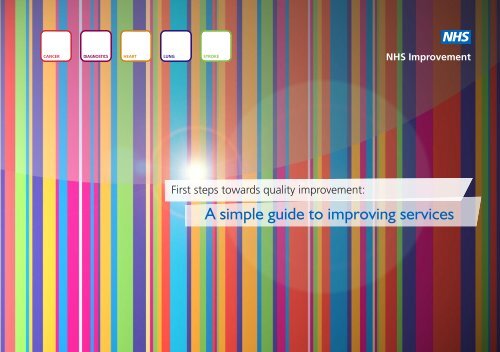
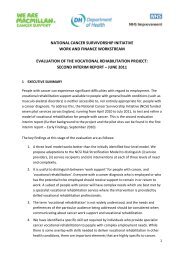



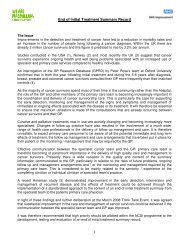
![Download the how to guide [PDF] - Macmillan Cancer Support](https://img.yumpu.com/47067428/1/184x260/download-the-how-to-guide-pdf-macmillan-cancer-support.jpg?quality=85)



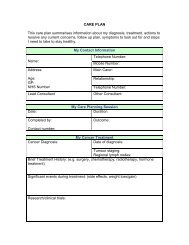


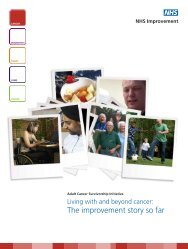
![HOPE Protocol [PDF, 420KB] - National Cancer Survivorship Initiative](https://img.yumpu.com/32566432/1/184x260/hope-protocol-pdf-420kb-national-cancer-survivorship-initiative.jpg?quality=85)